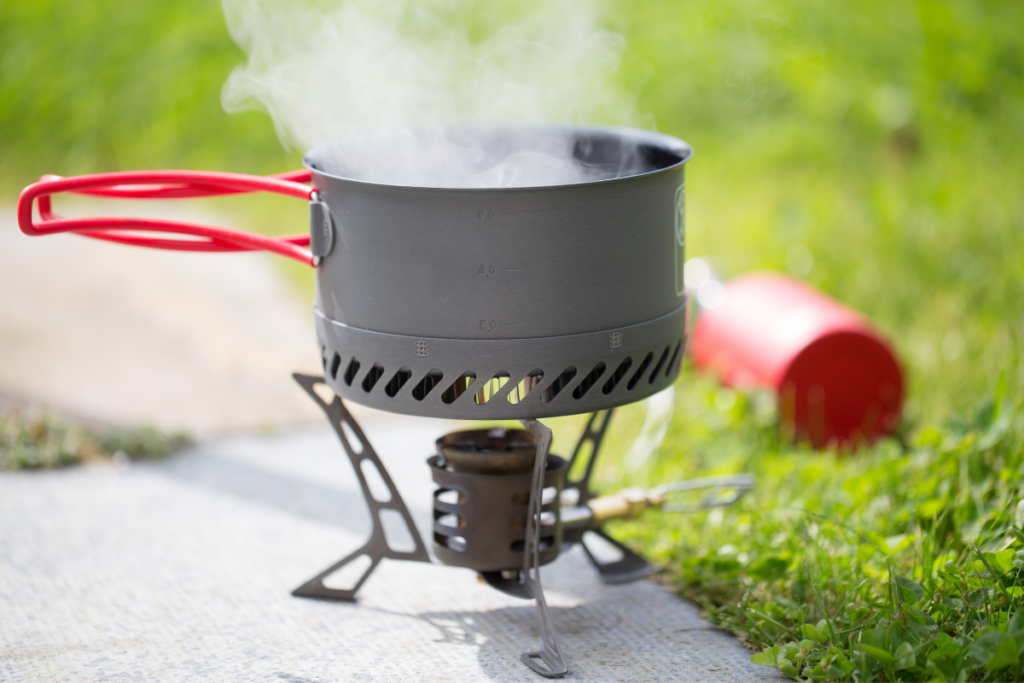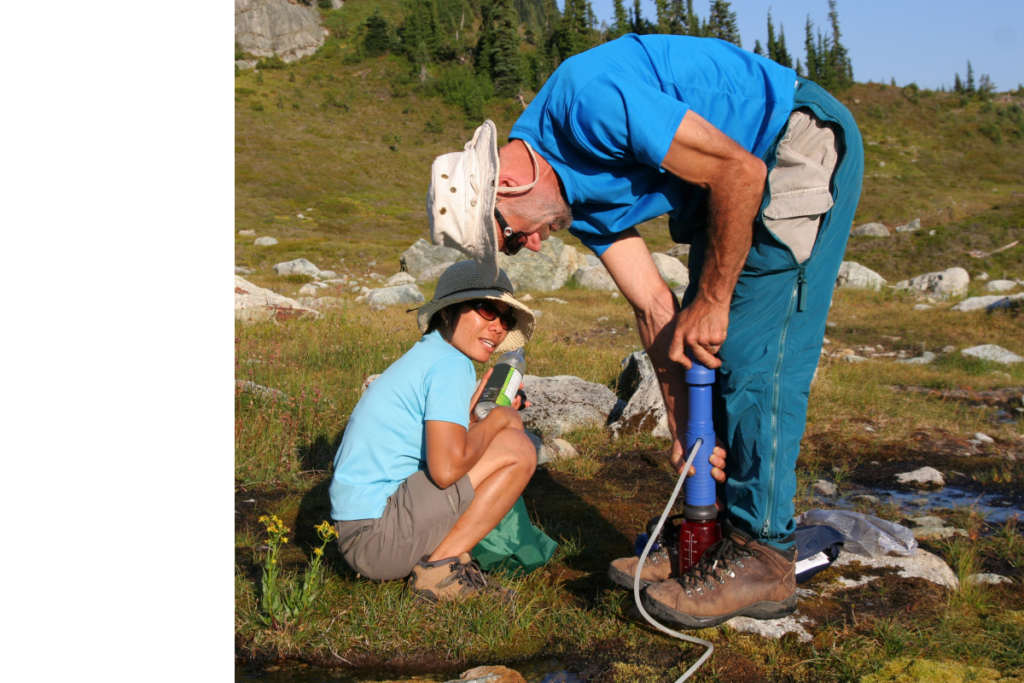
Did you know…
- A water access and treatment plan is essential for experiencing a safe trip in the backcountry.
- All water in the backcountry must be treated with an effective method prior to consumption.
- Understanding the advantages and drawbacks of each water treatment method can result in a selection that ensures water is safe to use.
- Follow the manufacturer’s instructions and pay close attention to potential points of cross-contamination when using a filter system.
Colorado offers endless opportunities to hike, camp, fish, climb, and appreciate other forms of outdoor recreation. Enjoying the outdoors requires users to act responsibly to preserve natural spaces and stay out of danger. Understanding water treatment options is critical to staying healthy on long treks through the backcountry.
- If it is not possible to carry enough drinking water from home, you must be prepared with a portable water treatment system and know how to use it safely.
- Treating water from a ‘wild,’ undeveloped source requires knowledge, planning, and awareness to use the resource and prevent sickness.
- A comprehensive water plan is essential for experiencing a successful and safe trip in the backcountry.
Contaminants of Concern
Even water in a remote location that seems untouched may be contaminated. There is no way to guarantee that water collected from the backcountry is safe, so it should always be treated prior to consumption. Even a robust immune system cannot prevent outdoor enthusiasts from experiencing illnesses which often last several days and may require treatment for recovery. When in the backcountry, the priority is to remove microorganisms that could make you sick. All water in the backcountry should be treated with an appropriate method prior to consumption. Information about several common contaminants and treatments methods are listed in the following table.
| Type of Contaminant | Risks | Removal Method |
|---|---|---|
| Protozoa Common examples: Cryptosporidium parvum, Giardia lamblia | Gastrointestinal disease: vomiting, diarrhea, nausea, dehydration, cramps | Boiling or filtration with absolute pore size of <0.1-micron NSF standard filter |
| Bacteria Common examples: Pathogenic E. coli, Salmonella | Gastrointestinal disease: vomiting, diarrhea, nausea, dehydration, cramps | Boiling, Iodine, Chlorination, or Filtration with absolute pore size of 0.3-micron or smaller |
| Viruses Common examples: Norovirus, Rotavirus, Hepatitis A | Gastrointestinal disease: vomiting, diarrhea, nausea, dehydration, cramps | Boiling, Iodine, or Chlorination Some filtration methods will remove viruses. |
| Sediment, Turbidity, Tannins | Poor taste, appearance, or odor: usually not acutely hazardous to ingest, but overall unpleasant to consume | Activated Carbon |
| Chemicals | Various adverse health risks depending on the chemical or metal, but primarily a concern with chronic consumption | Activated Carbon |
Treatment Options
Selecting effective water treatment requires learning about available methods and special consideration for your needs. Following guidance for each treatment method and doing your best to prevent contamination is essential to ensure that your water is safe to drink. There are pros and cons to each treatment method, from financial considerations to ease of use. Understanding the advantages and disadvantages of each method can result in a selection that will protect you during your time in the wilderness. If possible, using more than one treatment can increase the safety of the water collected from the backcountry, and can lower the risk from multiple types of contamination. To prevent cross-contamination of treated water, avoid reusing the same storage container.
Boiling Treatment

The Basics:
Often considered the most effective way to remove microorganisms, boiling water prior to consumption kills most living organisms. However, the higher elevations in parts of Colorado impact the temperature of boiling water so be sure and take that into consideration. Any water used for consumption below 2000 meters (6,562 feet) should be brought to a rolling boil for at least 60 seconds and cooled. Above 2000 meters, the water should be boiled for at least 3 minutes. Reaching and maintaining a full rolling boil for the entire time requirement is essential. Boiling the water for the necessary time ensures that all microbes are inactive. Remember to follow these guidelines for all water, including when preparing dehydrated meals, mixing infant formula, or giving your pet a drink. Depending on the county and time of the year, fire ban or restrictions may be in effect, preventing the use of boiling as a water treatment method. It is recommended to use a pot or kettle with a lid to prevent water loss during heating and to reduce the risk of accidental burns. Furthermore, boiling water can be difficult in inclement weather and take longer at higher elevations.
The United States Geological Survey (USGS) provides a website which can be used to help determine the elevation of your location.
| Pros of Boiling Treatment | Cons of Boiling Treatment |
|---|---|
| • Affordable and accessible to most recreators • Kills most pathogens • Cookstove doubles as water treatment method for backpackers • Uncomplicated process | • Does not remove chemicals or metals • Wait time for water to cool • Effectiveness depends on adequate boiling time and temperature • Must consider fire bans • Does not improve taste, color, or odor • Consumes fuel • Takes longer boiling time to destroy microorganisms at higher elevations |
Filtration Treatment

The Basics:
There are various filters that can be used to reduce the number of harmful microbes in untreated water. Some use gravity or a pump to move water from the source through the filter. The effectiveness of filters depends on the pore size of the filter, the amount of contamination, as well as the size and charge of the contaminant. Filters with a pore size of less than 0.1 micron will usually capture most bacteria. ‘Absolute’ means no pores are larger than stated while ‘nominal’ refers to average pore size. Certain types of filters can remove some viruses as well if they are equipped with a special disinfecting matrix. Follow the manufacturer’s instructions and avoid freezing temperatures which could affect poor structure. Always pay close attention to potential points of cross-contamination.
| Pros of Filtration Treatment | Cons of Filtration Treatment |
|---|---|
| • Removes most bacteria when used correctly • No wait time after filtering • Water may taste better, removes large particulates • Can be effective on water from a wide range of sources | • Can be expensive • Can be heavy • Needs to be replaced after a certain amount of use to remain effective • Must be stored and cleaned after use (maintenance); prone to clogging and breaking; may need to be replaced after heavy use |
Purification
Ultraviolet Light
The Basics:
Ultraviolet light purifiers use short wavelength light to kill pathogens. Typically, these devices are small, lightweight “wands” that are battery-powered or rechargeable. The wand is inserted into a water bottle and stirred for about 60 seconds. This technology only works on water that is clear so pre-filtering may be necessary. Carrying a backup treatment option is recommended.
| Pros of UV Light Treatment | Cons of UV Light Treatment |
|---|---|
| • Ultralight and portable • Little maintenance required • Water is disinfected and ready for consumption quickly | • Can only disinfect small volumes at a time • Bulb and batteries need to be replaced • Does not alter taste or odor • May required pre-filter step • Can be expensive |
Chemical Treatment
Iodine Tablets
The Basics:
Iodine tablets are a lightweight solution to killing most pathogens, including Giardia. Contact time varies depending on the manufacturer’s instructions, but two tablets usually disinfect about a liter of water in thirty minutes. Using iodine tablets alone leaves an unpleasant taste in the water. Some kits include vitamin C tablets to add post-disinfection. Vitamin C sequesters remaining iodine, thus improving the water’s taste.
| Pros of Iodine Treatment | Cons of Iodine Treatment |
|---|---|
| • Convenient to carry • Affordable • Easy to use | • Not suggested for pregnant women or those with thyroid conditions • Takes 30 minutes to use • Unpleasant taste • Does not inactivate Cryptosporidium cysts |
Chlorine Dioxide
The Basics:
Chlorine dioxide kills bacteria, viruses, and Cryptosporidium when used correctly, and may remove chemicals such as sulfides, cyanides, and phenols. It is safe to use in most conditions, and for most people. Using chlorine dioxide also improves water taste and odor. Chlorine dioxide is used by many municipalities in public water systems and is available in tablet form. This method requires 30 minutes of contact time for most pathogens, bacteria, and viruses, but requires four hours to inactivate Cryptosporidium.
| Pros of Chlorine Dioxide Treatment | Cons of Chlorine Dioxide Treatment |
|---|---|
| • Improves taste • Kills bacteria, pathogens, and viruses • Easy to use • Convenient to carry • Affordable | • Long contact time |
Other Considerations:
- Plan on consuming 0.5 liters of water per hour per individual. Add an extra liter of water for every additional 1,000 feet of elevation. Humidity and temperature will increase this requirement further. This is a baseline estimate, and individual water needs will vary.
- What is your group size? Will you have adequate treatment options for all members? Will you have access to enough water for the duration of your trip?
- Do you know how to set up and safely use your treatment device? Are you able to use it properly under any circumstances?
- The highest level of achievable protection from undeveloped water sources may come from using a combination of treatment options.
Questions to Consider:
- What is the water availability on your trip?
- Is there a way to avoid consuming water from an undeveloped source, especially stagnant water or areas frequented by humans?
- How has the weather influenced the availability of water sources?
- How will changes in elevation affect the efficacy of your treatment option?
- Can you use a combination of treatment options?
- Do you have a backup plan if one fails?

Test Your Knowledge!
Q: You plan to hike 6 miles in Rocky Mountain National Park with an elevation change of 2000 feet. There are 4 adults hiking in your group, and the high temperature is estimated to be 85 degrees Fahrenheit. Using these parameters, what is the minimum amount of water your group should carry or ensure access for the hike?
A: Using an approximation of 2 miles hiked per hour, you will need 1.5 liters per person, or 6 liters of water total. Since you are adding 2000 feet of elevation, you should add 2 extra liters per person, bringing the total up to 14 liters. The expected hot weather will further increase your need by about one liter per person. All in all, you may need 18 liters of treated water or more for this hike.
Resources:
CDC: A Guide to Drinking Water Treatment and Sanitation for Backcountry and Travel Use https://www.cdc.gov/healthywater/drinking/travel/backcountry_water_treatment.html
Minnesota Department of Health: Water Treatment in the Backcountry https://www.health.state.mn.us/diseases/waterborne/prevention/backcountry.pdf
American Hiking Society: Water Purification https://americanhiking.org/resources/water-purification/
Authors:
A. J. Modafferi, ERHS graduate student, H. Ramsdell, ERHS Associate Professor, and M. Bunning, Colorado State University Professor and Extension Specialist.


